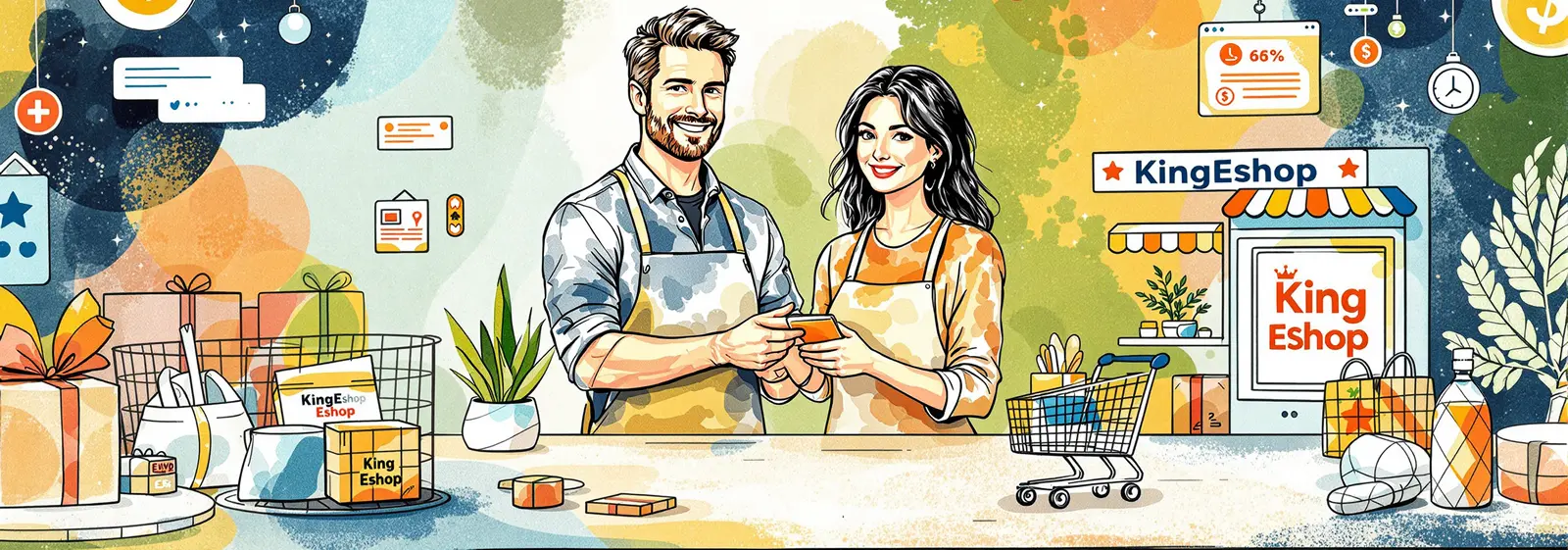Online store touchpoints
The ultimate guide
Written by Manuel Lamas  | Updated:
| Updated:

One touchpoint at a time ...
Definition of touchpoints in the customer journey
Touchpoints refer to every interaction between a customer and an online store , whether before, during or after the purchase. These interactions include ads, the website, social media, the checkout process, and follow-up emails. They create a web of experiences that shapes the overall perception of a brand.
Importance of optimized management for customer experience
Effective touchpoint management ensures that every interaction meets customer expectations. At KingEshop, with my years of experience helping over 130,000 online stores — especially those of artisans and small business owners — I've seen how consistency and quality in touchpoints can turn a simple visit into a purchase and build lasting customer loyalty.
Direct impact on conversions and loyalty
Optimized touchpoint management helps increase conversions and foster customer loyalty. For example, a smooth checkout process, a bundled discount offer well-placed or a well-crafted follow-up email can make the difference between a positive customer experience and frustration that leads to abandonment. With the right strategy, every touchpoint becomes an opportunity to strengthen customer relationships and boost sales.
Identify touchpoints in the customer journey
Touchpoints before purchase
Before a customer makes a purchase, they interact with multiple touchpoints that shape their perception of your online store:
• Advertising
Google Ads campaigns, Facebook Ads, and display banners.
• Social media
Interactions through posts, comments or private messages.
• Website
The homepage, blogs or guides that draw attention and capture interest.
Touchpoints during the purchase
These touchpoints are critical, as they determine whether the customer completes the purchase or not:
• Product page
Clear presentation with accurate descriptions, quality photos and customer reviews.
• Cart
Intuitive interface allowing quantity adjustments and promo code application.
• Checkout process
Simplicity and security to ensure a smooth and reassuring transaction.
Touchpoints after purchase
Once the purchase is made, these interactions strengthen the relationship with the customer:
• Customer service
Fast and efficient support in case of problems or questions.
• Follow-up emails
Order confirmation, delivery notifications, and personalized thank-you messages.
• Loyalty programs
Exclusive offers or accumulated points to reward regular customers.
Understand customer expectations at each touchpoint
Expectations before purchase
Customers look for transparent and engaging interactions before committing to a purchase:
• Clear information
Some accurate product descriptions, visible prices, and return policy details.
• Quick engagement
Quick replies via social media or live chat tools to resolve doubts or answer questions.
Expectations during the purchase
During this critical phase, customers expect a smooth and frictionless process:
• Smoothness
Intuitive navigation, fast page loading, and no technical errors.
• Security
Secure payments, HTTPS certificates, and multiple payment methods.
• Immediate assistance
Option to contact customer service if a problem arises during the purchase process.
Post-purchase expectations
Post-purchase interactions strongly influence customer loyalty:
• Proactive communication
Regular updates on order status, including confirmation and delivery.
• Efficient support
A responsive customer service to handle returns or resolve issues.
• Customer appreciation
Thank-you emails, invitations to leave a review or join a loyalty program.
Mapping the customer journey to optimize touchpoints
Creating a « customer journey map »
A customer journey map helps visualize every step a client goes through, from first interaction to loyalty.
• Key stages:
Identify the moments when the customer interacts with your store.
• Objective:
Understand the specific needs and expectations at each stage.
Identifying strengths and weaknesses
Analyze feedback to assess the effectiveness of your touchpoints.
• Strengths:
What works well, such as a responsive customer service or smooth navigation.
• Weaknesses:
Potential obstacles, such as an abandoned cart or long loading times.
Analysis of key moments to maximize impact
Focus your efforts on the moments when decisions are made:
• Before purchase:
Build trust with customer reviews and guarantees.
• During purchase:
Simplify the process to avoid cart abandonment.
• After purchase:
Build loyalty with personalized follow-ups and exclusive offers.
Strategies to improve pre-purchase touchpoints
Personalized and targeted ads
Invest in advertising campaigns tailored to your audience to grab their attention and lead them to your online store.
• Precise segmentation :
Use demographic, behavioral, and interest data to create relevant ads.
• Attractive formats :
Experiment with videos, carousels, and dynamic banners.
Using social media to engage and inform
Social media are powerful tools to establish a first connection with your prospects.
• Active engagement :
Reply to comments and messages to build a relationship of trust.
• Educational content :
Share guides, tutorials, or case studies to demonstrate your expertise.
Improve SEO to attract qualified traffic
Optimized organic SEO helps position your shop at the top of search results.
• Keyword research :
Target keywords specific to your niche to attract a relevant audience.
• Quality content :
Create informative and engaging pages that meet user needs.
Strategies to optimize touchpoints during the purchase
Designing a compelling and informative product page
A well-designed product page plays a crucial role in converting visitors into customers.
• Detailed descriptions :
Provide accurate information about the product's features and benefits.
• High-quality visuals :
Use high-resolution photos and, if possible, demonstration videos.
• Customer reviews :
Add testimonials to build trust.
Simplified and secure payment process
A smooth checkout process reduces cart abandonment and improves the shopping experience.
• Multiple payment options :
Offer various options such as credit cards, PayPal, or Apple Pay.
• - Clear interface :
Make sure the payment steps are simple and distraction-free.
• Enhanced security :
Add SSL certificates and security badges to reassure customers.
Integrating live chats to answer questions in real time
Live chat can clear customers' doubts and speed up their purchase decision.
• 24/7 Support :
If possible, provide continuous support to avoid missing opportunities.
• Personalized responses :
Adapt responses to each customer's specific needs.
• Smart chatbots :
Use artificial intelligence to handle frequently asked questions quickly and efficiently.
Strengthen post-purchase touchpoints
Confirmation and thank-you emails
Post-purchase emails are an excellent opportunity to boost customer satisfaction.
• Immediate confirmation :
Send an email as soon as the purchase is completed to reassure the customer.
• Personalization :
Use the customer's first name and mention the purchased products.
• Suggest recommendations :
Add complementary products or exclusive promotions.
Proactive management of returns and complaints
Efficient handling of returns and complaints shows your commitment to customer satisfaction.
• Clear policies :
Clearly display your return policy on your website.
• Fast support :
Respond quickly to requests to avoid frustration.
• Tailored solutions :
Offer refunds, exchanges, or credits according to the customer's preferences.
Loyalty programs and repeat purchase incentives
Building customer loyalty is essential to maintaining a long-lasting relationship.
• Loyalty points :
Offer points for each purchase, redeemable for discounts or gifts.
• Personalized offers :
Send promotions tailored to each customer's shopping habits.
• Exclusive surprises :
Offer special perks to your most loyal customers, such as early access to new collections.
Measuring the performance of touchpoints
Key Performance Indicators (KPI)
Tracking the right metrics helps evaluate the effectiveness of your touchpoints.
• Conversion rate:
Measures how many visitors become customers.
• Cart abandonment rate:
Identifies obstacles during the purchase process.
• Customer satisfaction:
Assess your customers' overall perception through surveys or reviews.
Use of analytics tools to track effectiveness
Analytics tools help gather precise data to optimize your touchpoints.
• Google Analytics:
Track user behavior on your website.
• Hotjar:
Analyze customer navigation using heatmaps and session recordings.
• Customer Feedback Tools:
Collect customer feedback to better understand their expectations.
Importance of customer feedback to refine strategies
Customer feedback is a goldmine of insights to improve user experience.
• Post-purchase surveys:
Send questionnaires to understand positive and negative points.
• Customer reviews :
Analyze reviews to identify areas for improvement.
• Active listening on social media:
Monitor comments to spot trends and anticipate needs.
Personalization of touchpoints
Using customer data for tailored experiences
Leveraging available data allows you to personalize every interaction with your customers.
• Behavioral analysis:
Use navigation data to suggest relevant products.
• Customer segmentation:
Group your customers by interests, purchase history, or behaviors.
• Integrated CRM:
Centralize customer information for consistent and effective interactions.
Automated product recommendations
Automated recommendations increase relevance and conversions.
• Recommendation engines:
Recommend products based on past purchases or recent browsing.
• Cross-selling and upselling:
Suggest complementary or premium items.
• Personalized emails:
Include recommendations in post-purchase emails or marketing campaigns.
Marketing messages tailored to individual preferences
Adapt your communications to maximize their impact.
• Dynamic emails:
Create tailored messages based on preferences and buying behavior.
• Targeted offers:
Offer personalized promotions or discounts to retain your customers.
• Social media:
Deliver ads and content tailored to the specific interests of each segment.
The importance of consistency across touchpoints
Alignment of messaging and experience across all channels
Consistent messaging builds customer trust and engagement.
• Unified communication:
Ensure your marketing, advertising, and customer service messages convey the same values.
• Visual consistency:
Maintain the same colors, fonts, and styles across your platforms.
• Harmony in offers:
Promotions and information must be consistent across all channels (website, social media, emails).
Maintain a strong and recognizable brand identity
A consistent brand identity helps you stand out and build loyalty.
• Consistent tone and voice:
Keep a consistent writing style in all your communications.
• Logo and design:
Ensure your logo and visuals are well integrated across all platforms.
• Shared values:
Make sure your values shine through in every customer interaction.
Delivering a seamless omnichannel experience
An omnichannel approach ensures a smooth transition between different touchpoints.
• Data synchronization:
Integrate customer data across all channels for smooth interactions.
• Continuity of experience:
Allow customers to start a purchase on one channel and complete it on another without barriers.
• Omnichannel personalization:
Adapt recommendations and messages at each touchpoint based on previous interactions.
Practical case studies
Example 1: Increased sales through product page optimization
An online clothing store improved its product pages by adding:
- Detailed and engaging descriptions.
- High-quality photos with multiple viewing angles.
- Customer reviews directly visible on the page.
• Result:
A 25% increase in conversions on optimized product pages.
Example 2: Reduction in cart abandonment with a redesigned checkout process
An electronics gadget website simplified its checkout process by:
- Reducing the number of steps required to complete the checkout.
- Adding a guest checkout option to avoid mandatory accounts.
- Offering multiple secure payment methods.
• Result:
A 15% decrease in cart abandonment rate.
Example 3: Increased loyalty through engaging post-purchase emails
An organic products store implemented personalized emails after each purchase:
- A thank-you email with a discount for the next order.
- Suggestions for complementary products based on previous purchases.
- A request for feedback to strengthen customer engagement.
• Result:
A 30% increase in repeat orders.
Tools to manage touchpoints
CRM tools to centralize customer interactions
CRMs (Customer Relationship Management) make it possible to gather all customer interactions in one place.
• Benefits:
Tracking purchase histories, managing customer inquiries, and personalizing communications.
• Tool examples:
HubSpot, Salesforce, Zoho CRM.
Marketing automation platforms for efficient management
Automating marketing tasks helps maintain consistent relationships with clients without manual effort.
• Use cases:
Sending welcome emails, abandoned cart notifications, and loyalty campaigns.
• Example platforms:
Mailchimp, ActiveCampaign, Klaviyo.
Analytics and data tracking to measure impact
Analytics tools help assess touchpoint effectiveness and identify areas for improvement.
• Tracked indicators:
Click-through rate, conversion rate, and engagement rate.
• Tool examples:
Google Analytics, Hotjar, Mixpanel.
Common mistakes in touchpoint management
Neglecting post-purchase channels
Post-purchase interactions are crucial for building customer loyalty.
• Issue:
Not sending follow-up emails or ignoring customer feedback.
• Solution:
Implement post-purchase communications such as thank-you notes, satisfaction surveys, or loyalty offers.
Lack of consistency between messages across different channels
Conflicting or misaligned messages can disrupt the customer experience.
• Issue:
Use of different tones or information between social media, emails, and the website.
• Solution:
Harmonize your communication strategy to ensure a consistent experience.
Ignoring customer feedback and frustrations
Not taking customer feedback into account can damage your brand image.
• Issue:
Not responding to negative reviews or complaints.
• Solution:
Establish a clear process to collect, analyze, and act on customer feedback.
Future trends in touchpoint management
Increased use of artificial intelligence to personalize interactions
AI helps better understand and respond to customer needs.
• Example:
Smart chatbots that adapt their responses based on customer history.
• Benefit:
Deliver personalized and real-time experiences.
Expansion of touchpoints through the metaverse and augmented reality
New technologies open up opportunities to enhance interactions.
• Example:
Virtual stores in the metaverse or product trials in augmented reality.
• Benefit:
Create immersive experiences that captivate the audience.
Advanced automation for smooth and responsive management
Automated management improves response speed and efficiency.
• Example:
Automatic sending of follow-up emails or offers based on user behavior.
• Benefit:
Reduce workload while maintaining excellent service quality.
Conclusion: Maximize customer experience through effective touchpoint management
Summary of best practices
Effective touchpoint management relies on a thoughtful, customer-centric approach. Whether it's pre-purchase ads, streamlined checkout processes, or post-purchase loyalty programs, every interaction should be optimized to deliver a smooth and engaging experience.
Importance of a proactive and omnichannel strategy
Adopting an omnichannel strategy ensures message consistency and delivers a seamless experience across all touchpoints. Being proactive means anticipating customer needs and adjusting your interactions to maximize satisfaction and loyalty.
As the founder of KingEshop, I've seen how optimal touchpoint management can transform the customer experience and boost online store sales. I encourage you to fully leverage modern tools like CRMs, marketing automation, and data analytics to optimize every customer interaction.
With KingEshop, we have supported over 130,000 online stores in their quest for growth. A well-thought-out touchpoint strategy is a powerful lever to turn visitors into loyal customers. So start maximizing the impact of every interaction today!
Thank you for reading this page all the way through!


